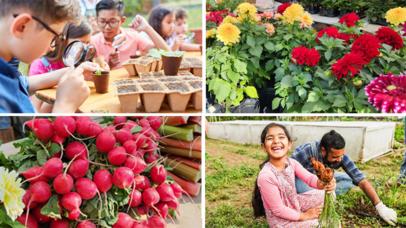 By: By: Kendall Hunt RPD Editorial and Development Team
By: By: Kendall Hunt RPD Editorial and Development Team
Gardening, one of the world’s oldest hobbies, is universally associated with nutrition, physical health, and community beautification. Today, June 6, as we celebrate National Gardening Exercise Day, it’s the perfect time to reflect on the benefits that gardens offer students. Beyond physical exercise and fresh produce, gardens provide a unique opportunity for students to connect with nature and enhance their overall wellness.
Students involved in gardening programs develop essential life skills such as collaboration, communication, and teamwork. These experiences teach the value of hard work and shared efforts. By creating and tending to gardens, students not only engage with the outdoors but also foster curiosity and a sense of connection from an early age.
When planning a school garden, educators and students should consider various factors, including the type of garden, , plant selection, and the importance of a secure location. Researching and understanding elements that may impact the garden’s success can be both rewarding and interesting.
School gardens go beyond beautification-they contribute to student well-being, social skills, and a positive learning environment. As an educator, encourage your school and classroom to implement a gardening project. Here are three options for how to plan your garden project, and explore options for seasonal blooms in spring, early summer, and fall.
Let’s dive into creating a spring-blooming garden, also known as “Flower Power.”
Spring-blooming Garden: Flower power
For novice gardeners, a spring-blooming garden offers an excellent staring point since many flowers and bulbs are planted in the fall and left dormant during the winter, to bloom on their own in the spring. Teachers can reference the garden and the life cycle of seeds and bulbs during science lessons throughout the winter, in preparation for spring blooms.
When to plant: fall, just after students return to school.
When to expect blooms: weather-dependent, April-May
What to plant: Tulips, daffodils and garlic are good low-maintenance bulb options. They won’t bloom until spring, but pansies enjoy the cool weather and will bloom immediately in the fall. Over the winter, they’ll strengthen their roots to bloom again even more prominently in the spring.
Remember, timing matters! Plant your spring-blooming garden just after students return to school in the fall.
Summer-blooming Garden: Birds and butterflies
Summer-blooming gardens provide a habitat for birds and butterflies, offering a chance to teach students about these pollinators. Students will discover what living things need for survival (food, water, and shelter) and will see connections between their own needs and the animals’. A summer garden reinforces students’ place as a member of the natural world and God’s creation!
When to plant: spring, after danger of late spring frost (late April-May)
When to expect blooms: late May-early June, continuing into summer
What to plant: We recommend sun-loving, brightly colored native flowers, including both annuals and perennials. Possibilities include aster, purple cone flower, sunflower, lupine, daisy, goldenrod, salvia, sage, butterfly bush (Buddleia), hollyhock, milkweed, honeysuckle, lantana, and star jasmine. You should also provide birds with additional food options (thistle seeds, suet blocks, and commercial seed mixes work well), as well as a source of fresh water no more than two or three inches deep.
Fall-blooming Garden: Nature’s bounty
If you want to have your garden and eat it too, a fall-blooming garden is your best chance. Teachers can introduce students to new vegetables and reinforce the importance of locally grown produce (perhaps a field trip to a local farmers’ market would be appropriate). Fall-blooming gardens’ one disadvantage is that they do most of their actual growing during the summer. However, kids can still be involved in the planting and harvesting and can help put the garden “to bed” for the winter.
When to plant: just as school gets out (late May-early June)
When to expect produce: early to mid-September to October
What to plant: Tomatoes, peppers, sweet potatoes, winter squash, and onions are all long-growing plants which take between 80 and 100 days to mature. If you get them in the ground in May, they’ll be ready for your harvest in the fall.
What exciting plans do you have for your classroom garden this fall?
Sources:
https://www.gardensalive.com/product/perfect-plants-for-a-school-garden-during-the-school-year
https://cpb-us-e1.wpmucdn.com/blogs.cornell.edu/dist/0/4074/files/2014/06/school-garden-crops-2013-1npotbc.pdf